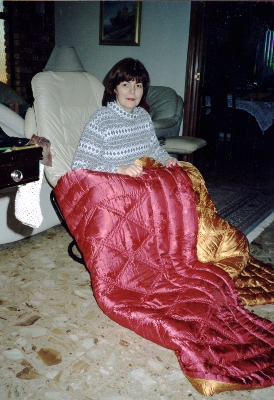Quilt No.579MR - Mileva Robev
2000 x 1500mm
Mileva's mother ordered the quilt from a local quilt maker in Macedonia for her daughter's dowry. It came to Australia with Mileva and her husband Trifun in 1966 and is still owned by Mileva. It is used occasionally.
"Mileva's Quilt
In keeping with tradition Mileva's mother Velika, ordered this quilt from the local quiltmaker in the city of Bitola, in southern Macedonia (part of the former Yugoslav Republic). The quilt was part of Mileva's dowry (called 'prike' or 'cheiz') and also part of the preparations which Mileva's parents had made for coming to Australia. They had taken the big decision of migrating to a country which, they felt, offered more prospects for a better life for them and their children.
Mileva, although only seventeen and still at high school, wanted to marry her young man, Trifun Robev. Her parents had agreed that they would marry, but felt that Mileva was too young and should first complete her education. However, Mileva had other ideas when faced with the prospect of leaving for Australia within the month. Returning from Belgrade where they had been for their various medicals and other travel arrangements, she and Trifun decided to elope, causing much concern and consternation throughout their families and community!
Eventually the family came to Australia by ship. Mileva and her husband followed some time later, arriving by air in 1966. Mileva was seven months pregnant with their son Nicholas. Later they had their second child, daughter Sonia. The lovely satin quilt from Macedonia was much used in the early years of the children. And now there are grandchildren, Billie and Nikki, children of Nicholas and his wife Daniella. The quilt is still in excellent condition."
[Written by Lula Saunders, adapted from interview 29/7/99 for the National Quilt Register]

Related Quilts:
2360 x 2310mm
11920 x 1830mm
2000 x 1600mm






